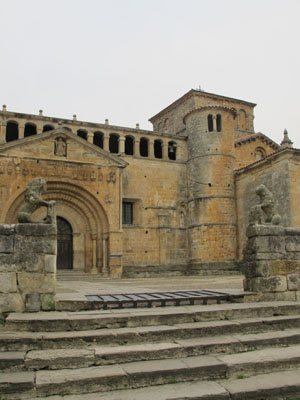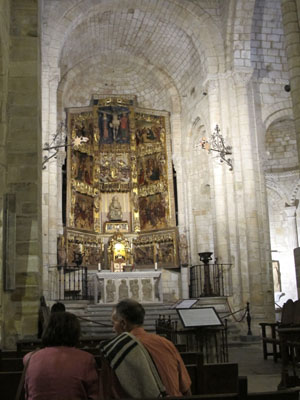| |
 |
 |
 |
| Comment on this report, or find other reports. |
 |
| Our Mystery Worshippers are volunteers who warm church pews for us around the world. If you'd like to become a Mystery Worshipper, start here. |
 |
| Find out how to reproduce this report in your church magazine or website. |
|
|
| 2312: Colegiata
de Santa Juliana, Santillana del Mar, Cantabria, Spain |
 |
 |
 |
Mystery
Worshipper: Augustine the Aleut.
The church:
Colegiata de Santa Juliana, Santillana del Mar, Cantabria, Spain.
Denomination:
Roman Catholic,
Diocese
of Santander.
The building:
The 800-year-old Colegiata de Santa Juliana shelters the tomb
of the village's patron saint, Juliana. Around 870, local monks
built a hermitage to house some of her relics. Fernando I of
Castile endowed the monastery, which eventually passed from
Benedictines to Augustines. Most of the existing church is from
the 12th and 13th centuries, although it was extended during
the Renaissance. The altar and its retablos justify the description
of Flamboyant Gothic. Many of the altars and their decorations
are from the Renaissance period, when the gold and silver of
the Americas came pouring in, especially through the nearby
ports of northern Spain. The town features a number of small
palaces built during this period, adding to its attraction for
tourists. The cloister carvings are remarkable. A Google image
search will reward the seeker with undamaged examples (rare,
given the anticlerical nature of civil wards and rebellions
in Spain) of the mediæval sculptor’s skill and imagination.
The church:
The church’s interior betrays its monastic character, so that
monks could fulfill their daily offices, rather than have the
church serve merely as a mass barn for the faithful. In recent
years it has become the town’s parish church. Among the treasures
displayed are 1000-year-old documents and a 17th-century Mexican
silver altarpiece. Juliana of Nicomedia, martyred under the
Diocletian persecution, is often represented as leading the
devil on a chain, after she had bested him in an argument. A
friend of mine believes she should be the patron of women undergoing
comprehensive examinations for graduate degrees.
The neighbourhood:
The old saw that Santillana del Mar is the Town of Three Lies
– not holy (santa) nor flat (llana) nor
on the sea (mar) – in reality has nothing to do
with the origin of its name (Santa Juliana, or Santa Illana).
After a 35km schlep from Santander, the pilgrim enters via a
cobbled lane, more picturesque than practical, with a stunning
view of the church. The town is built around the church, which
adjoins one of the two main squares. Side streets radiate from
the square, containing either modest if comfortable pensions
(my choice) or the €150/night parador. The pilgrims’ hostel
is very nice, and can be found behind a gallery of local art.
For reasons I couldn’t figure out, the collegiate church’s canons
drove the Dominicans out of town in the 16th century and, protected
by the Duke of Infantado, the friars built the church of Regina
Coeli, which now features a museum of religious art. To top
off the tourist attractions, the nearby caves at Altamira feature
some of the continent’s best prehistoric cave paintings.
The cast:
No idea.
The date & time:
Wednesday, 12 October 2011, 6.30pm.
What was the name of the service?
Evening Mass.
How full was the building?
The church might fit in about 200 and was fairly full – I counted
72 men and 103 women. While there was a fair age spread, the
middle-aged and prosperous predominated.
Did anyone welcome you personally?
Well, I was thoroughly examined by two security guards and an
Uzi-toting member of the famed Guardia Civil, who were
checking out members of the congregation as we arrived. As their
eyes narrowed at my less-than-bourgeois appearance, I told them
in halting Spanish that I was a Canadian pilgrim walking to
Santiago. One guard smiled (apparently the protection of pilgrims
is part of the Guard’s mandate – and it is much better to be
on the good side of the Guardia Civil than the bad
side), tipped his cap at me, and waved me through. I gathered
that there was some important personage there, of the sort who
required protection. Knowing Spain, it could have been a minor
member of the Royal Family, or it could have been a football
player. In either case, the slightest unpleasant incident would
cause trouble. Aside from this, I had some smiles of welcome
from some of the local workers as well as some of the very proper
older people. A very elderly woman, old enough to have seen
the armies march through here on their way to the bloody Battle
of Santander in 1937, came up to wish me a good voyage.
Was your pew comfortable?
I looked for a spot by a pillar where I could dive for cover
if need be. The pew itself had been built for long services
and was quite comfortable.
How would you describe the pre-service
atmosphere?
Everyone seemed a little alert, either waiting for the mysterious important person, or un-nerved (as I was) by the presence of automatic weaponry near the narthex.
What were the exact opening words of the
service?
The usual invocation of the three persons of the Trinity.
What books did the congregation use during the
service?
They followed the service by memory or, in the case of foreign pilgrims, we didn't.
What musical instruments were played?
There was no singing, aside from an a cappella hymn
during the communion, but the organ played some very nice introductory
music. One of my Catalan acquaintances identified it as a piece
by the Renaissance composer and organist Antonio de Cabezón.
Did anything distract
you?
One tends to be a little alert in a setting where security is
in order – shades of my previous pre-retirement incarnation
when I worked state funerals and played guessing games at which
congregants might be armed Royal Canadian Mounted Police.

Was the worship stiff-upper-lip,
happy clappy, or what?
The service was formal but relaxed, in the Spanish manner.
Exactly how long was the sermon?
8 minutes.
On a scale of 1-10, how good was the preacher?
2 – Difficult to say, as I found the priest's very rapid
speaking too fast for me to follow. Clergy may wish to note
that not all congregants are fluent in the local language.
In a nutshell, what was the sermon
about?
As his Castilian was too speedy for me, I was quite lost. After
two or three minutes of confusion, I relaxed with some mental
blankness. Note that I had walked 34.9 km from Santander, so
I claim the right to mental exhaustion.
Which part of the service was like being in
heaven?
I liked the feel of the building and its beautiful cloister and the paintings of Saint Juliana. Renaissance organ music is always a delight for me, and it was very soothing while challenging.
And which part was like being in... er... the other place?
Waiting for something to blow up.
What happened when you hung around after the service looking lost?
Half the congregation sprinted out, apparently so that they
could see the Important Person get into his car. I missed this
and exited with the mobility-impaired, comprising older Spaniards
with walking sticks and hobbling pilgrims.
How would you describe
the after-service coffee?
No after-service coffee here, but the Catalan accountants and
I decided to look for some good rockfish in a nearby restaurant.
Emptying a bottle of cava, we had an agreeable evening talking
about the Spanish church (one had been briefly a novice). The
waiter thoughtfully left the bottle of brandy on the table for
us as we finished our coffee.
How would you feel about
making this church your regular (where 10 = ecstatic, 0 = terminal)?
7 – It had a nice feel to it, but I think out of fairness I would have to check out the Dominicans to see what they were like. They might have a better preacher, even if I would miss out on the canons' idiosyncratic birettas.
Did the service make you feel glad to be a
Christian?
As in many other places in Spain, the quiet friendliness of parishioners to this stranger among them.
What one thing will you remember about all this in seven days' time?
The friendly guard with his Uzi.
More Camino reports |
|
|
 |
 |
 |
| We rely on voluntary donations to stay online. If you're a regular visitor to Ship of Fools, please consider supporting us. |
 |
 |
 |
| The Mystery Pilgrim |
 |
| One of our most seasoned reporters makes the Camino pilgrimage to Santiago de Compostela in Spain. Read here. |
 |
 |
 |
| London churches |
 |
| Read reports from 70 London churches, visited by a small army of Mystery Worshippers on one single Sunday. Read here. |
| |
|
|
|
|


